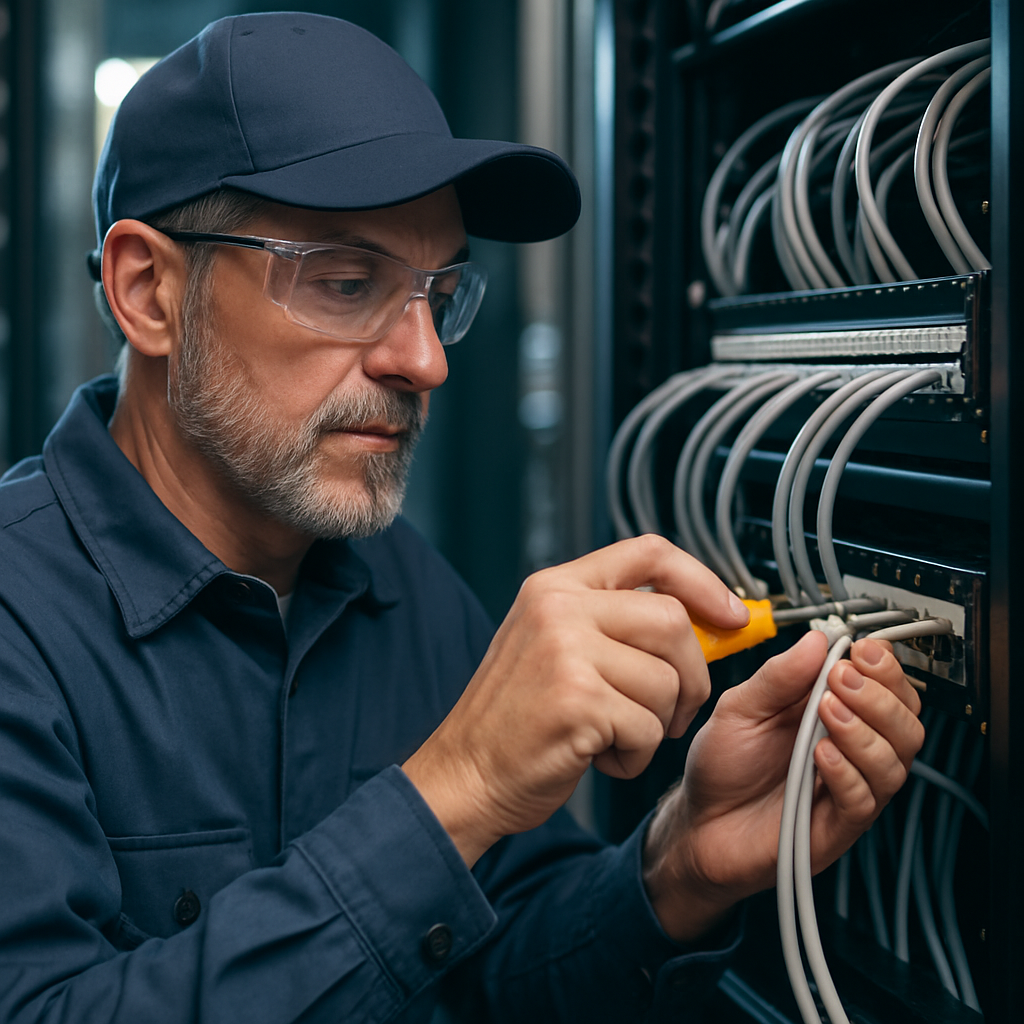Structured Cabling Color Codes: What Each Cable Color Means
In a structured cabling system, knowing what each cable does shouldn't take guesswork. With the right color code standard in place, a technician can...
7 min read
 Kevin Murphy
:
Oct 27, 2025 6:15:00 AM
Kevin Murphy
:
Oct 27, 2025 6:15:00 AM
Fiber optic cables are the invisible highways of our digital world, carrying massive amounts of data at the speed of light. But what happens when you need to join two cables to extend a network or repair a break? You can't just twist them together.
This is where fiber optic cable splicing—the process of creating a permanent, high-performance join between two fiber ends—becomes critical. For network managers and technicians, a poor splice can lead to significant signal degradation, network downtime, and costly troubleshooting.
At Turn-Key Technologies, we've spent decades building and maintaining high-performance networks, and we know that a reliable connection starts with a perfect splice. This guide cuts through the complexity, comparing the core fiber splicing methods and outlining the precise steps required for a successful, low-loss connection.
Fiber optic splicing is the process of joining two optical fibers end-to-end. Unlike using connectors, which are designed for frequent connection and disconnection at patch panels, splicing creates a permanent, stable joint with minimal light loss. This process is fundamental to building and maintaining a robust fiber network, ensuring signal integrity across long distances and through complex installations.
Fiber optic splicing is not just for repairs; it's a core technique used in building network infrastructure from the ground up. It is essential for extending long-haul telecommunication and ISP network backbones where cable spools, often several kilometers long, must be joined together. In campus or large enterprise environments, splicing is used to connect building backbones or extend a network cable run beyond the maximum length available on a single spool. Finally, it's the go-to method for emergency repairs, such as fixing a cable accidentally cut by construction equipment—an event often called "backhoe fade."
While both splices and connectors join fibers, they serve different purposes and have distinct performance characteristics. Splicing creates a permanent bond with very low signal loss (attenuation) and back reflection, making it the preferred method for permanent installations within a cable run. Connectors, on the other hand, are designed for flexibility at termination points like patch panels or equipment ports. However, they introduce significantly higher insertion loss and reflection, which can degrade network performance if used in place of splices for permanent joins.
The two primary industry-accepted methods for fiber optic cable splicing are fusion splicing and mechanical splicing. The choice between them depends on performance requirements, budget constraints, and the specific application environment. Understanding the differences is key to planning a successful structured cabling installation.
Fusion splicing uses an electric arc to precisely melt and fuse two cleaved fiber ends together, creating a single, continuous optical fiber. This method results in the strongest and most reliable joint with the lowest possible signal loss, typically less than 0.1 decibels (dB). The process requires a fusion splicer, a high-precision machine that aligns the fiber cores and controls the arc. While the initial investment in fusion splicing equipment is high, the per-splice cost is very low, making it the superior choice for data centers, long-haul networks, and any mission-critical application where signal integrity cannot be compromised.
Mechanical splicing physically aligns the ends of two fibers within a small, specialized housing. An index-matching gel inside the housing bridges the microscopic air gap between the fiber tips, allowing light to pass through with minimal reflection. This method is faster, requires no external power, and involves a much lower initial investment in tools compared to fusion splicing. However, mechanical splices introduce higher signal loss (typically 0.2 dB to 0.75 dB) and are generally considered less reliable over the long term, making them best suited for temporary or emergency repairs and some short-distance, low-speed network applications.
A pristine, low-loss splice is the result of a meticulous and repeatable process. Rushing or skipping any of these steps is the most common cause of splice failure and network performance issues. Whether you choose fusion or mechanical splicing, the initial preparation of the fiber ends is nearly identical and absolutely critical.
Safety Note: Always treat fiber as a live optical system. Verify light is off before opening a cable, use laser safety practices (no direct viewing into fiber ends), and dispose of glass shards in a designated container to prevent eye and skin injuries.
First, the outer cable jacket, armoring, and internal buffer tubes must be carefully stripped back to expose the individual optical fibers. Technicians then use a precision fiber stripper to remove the 250-micron acrylate coating from the end of each fiber, exposing the 125-micron bare glass cladding. It is crucial to use the correct stripping tool and a smooth motion to avoid putting any nicks or scratches on the fiber, as these defects will compromise the splice.
Any dust, oil, or debris on the bare fiber will prevent a proper splice and cause significant signal loss. The exposed fiber must be cleaned immediately after stripping using a lint-free wipe dampened with 99% or higher pure isopropyl alcohol (IPA). The proper technique involves a single, gentle wipe in one direction, rotating the fiber, and then using a new part of the wipe for a second pass to ensure no contaminants are dragged back onto the clean surface.
To formalize acceptance, align cleaning and inspection with IEC 61300-3-35 endface criteria. For performance targets, aim for splice reflectance of ≤ −55 dB for fusion (often ≤ −60 dB) and ≤ −35 dB for mechanical, noting that cleanliness and cleave angle drive both loss and reflectance.
A fiber cleaver is a specialized tool that precisely scores and breaks the glass to create a perfectly flat end-face that is exactly 90 degrees to the fiber axis. According to authoritative guides from the Fiber Optic Association, a poor cleave angle is a primary cause of high splice loss. A high-quality cleaver is non-negotiable for achieving acceptable results, especially for fusion splicing, where the goal is a near-seamless connection.
With the fibers prepared, they are placed into the splicing device. A fusion splicer uses cameras to automatically align the cores before firing the electric arc, while a mechanical splice requires the technician to carefully insert the fibers until they touch. After a fusion splice is complete, a heat-shrinkable splice protection sleeve is placed over the splice and heated to create a rigid, protective barrier. For both methods, the completed splice is carefully placed into a splice tray, which organizes and protects the delicate fibers within a larger splice closure.
Every component in a fiber optic link—connectors, cables, and splices—introduces a certain amount of signal loss, or attenuation. A loss budget is a calculation that sums up all the expected losses in a cable run to ensure the total attenuation is within the acceptable limits for the networking equipment to function correctly. Proper splicing is a key factor in keeping the total link loss low.
Splice loss is the amount of optical power lost at the point where two fibers are joined. It is primarily caused by extrinsic factors like contamination on the fiber ends, poor cleave angles, and misalignment of the fiber cores. It can also be caused by intrinsic factors, such as slight manufacturing variations between the two fibers being spliced. Careful technique and clean tools are the best defense against excessive splice loss.
Industry standards provide clear benchmarks for acceptable splice performance. For example, the TIA-568 standard specifies a maximum loss of 0.3 dB for any splice. However, modern best practices and equipment allow for much better results. As of late 2025, high-quality fusion splices consistently achieve losses of 0.05 dB or less.
Consider a 600 m OM4 run with two LC connectors and four intermediate splices.
Case Note: In a recent data center backbone upgrade, our team performed over 800 fusion splices for a 100 Gbps network. The client’s specification required an average splice loss of no more than 0.1 dB. By enforcing a strict "clean, cleave, inspect" protocol before every splice, we achieved an average loss of just 0.02 dB, as verified by OTDR testing. This high-performance result provided the client with significant margin in their loss budget, ensuring network reliability and future-proofing their infrastructure. You can explore our case studies for more examples of our work.
Achieving a professional-grade fiber optic splice requires a specialized set of tools and equipment. While the fusion splicer or mechanical splice assembly is the star of the show, the supporting cast of preparation and testing tools is just as important for ensuring a low-loss, reliable connection.
The primary piece of equipment is either a fusion splicer or a mechanical splice assembly kit. Alongside it, a high-precision fiber cleaver is essential for creating the perfect end-face required for a low-loss joint. After the splice is made, an Optical Time-Domain Reflectometer (OTDR) is the definitive tool used to test the splice quality, pinpointing its exact location and measuring its loss.
The foundation of a good splice is flawless preparation. A technician's toolkit must include three-hole fiber strippers to remove the jacket, buffer, and coating without damaging the fiber. A dispenser with 99%+ isopropyl alcohol and lint-free wipes are non-negotiable for cleaning. Additionally, tools like Kevlar shears and cable slitting tools are needed to access the fibers within the larger cable structure.
Once a splice is created, it must be protected. Heat-shrink splice protection sleeves are used for fusion splices to provide mechanical strength. Both fusion and mechanical splices are then secured in a splice tray, an organizer that prevents fibers from being bent too tightly. These trays are housed within a splice closure, a robust enclosure that protects the splices from moisture, dirt, and physical damage in both indoor and outdoor environments.
While this guide provides a solid overview of fiber optic cable splicing, the successful execution of these methods requires extensive training, hands-on experience, and a significant investment in precision equipment. For business-critical networks where performance and reliability are paramount, professional splicing services are a necessity. A deep knowledge of understanding structured cabling principles is the foundation for high-quality fiber work.
Engaging a professional partner ensures that every splice is performed cleanly, tested accurately, and documented properly. Certified technicians use calibrated equipment to guarantee that each splice meets stringent industry standards, protecting your network from the subtle performance degradation that can be so difficult to troubleshoot later. Whether you are building a new network or repairing an existing one, expert hands ensure the job is done right the first time.
Ensure your fiber network operates at its peak performance. Contact us for fiber splicing service and let our certified technicians handle your critical connections.

Kevin has been with Turn-key Technologies since 2012, overseeing cabling teams and managing projects from concept to completion. With deep expertise in structured cabling installations—including fiber optics, Cat5/5e/6/6a, and coax systems—he works closely with clients and engineers to deliver reliable, high-quality solutions on time and on budget.
Certifications:
NJ Division of Consumer Affairs
• Uniform & Construction Code
• Residential Fire Alarm Systems
• Smoke Detection Systems
• NJ Barrier Free Subcode
• ADA & Licensing Law
NYS Licenses
• Security & Fire Alarm License
• Electrical Training Center Fire Alarm Certification
BICSI & Technical
• Designing for PoE Lighting
• Fiber Optic & Connector Termination
• Firestop 101
Other Certifications
• OSHA 30-Hour Construction Safety
• Verkada Certified Engineer
• Avigilon Access Control Manager 6

In a structured cabling system, knowing what each cable does shouldn't take guesswork. With the right color code standard in place, a technician can...

6 min read
A high-performance network is built on thousands of precise details, but few are more critical than the termination point. A flawless cable run can...

What’s the cost of a messy cable setup? When cables are crammed, mislabeled, or routed poorly, systems overheat, repairs take longer, and downtime...